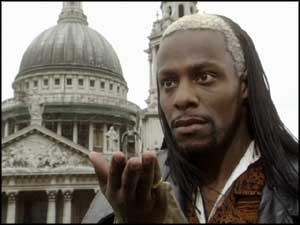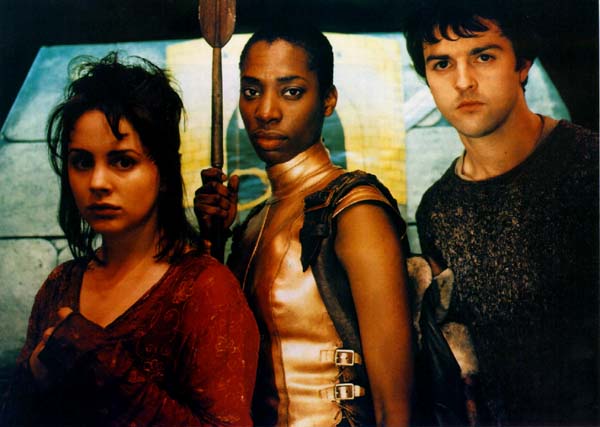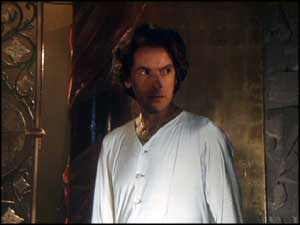
Neil Gaiman must be feeling pretty good right about now. Henry Selick’s excellent stop-motion animated film of his children’s book Coraline was both a financial and critical success, and has just been released on DVD. His last children’s novel, The Graveyard Book, was a huge success and is about to made into a film directed by Neil Jordan. And there’s always that comfort that comes from having your comic book mentioned whenever there’s a discussion about the greatest graphic novels ever written (The Sandman, of course). Indeed, many of Mr. Gaiman’s works are being mooted as possible films. Although The Sandman has been locked in development hell thanks to terrible scripts and spiralling budgets, there have been rumours of a Death movie shooting soon, that aforementioned Graveyard Book film, and, perhaps most interestingly, a feature film version of Neverwhere.
The history of Neil Gaiman’s Neverwhere is an odd, complicated one. Based on an idea by Gaiman and Lenny Henry, the story first saw the light of day in 1996 as a television series on the BBC. Frustrated by what he saw as the inevitably compromised end result (money and time maliciously conspiring together, as they often do), Gaiman went off and wrote the book, which was released during the series’ run. Finally, there’s the Mike Carey graphic novel based on the book (Carey having written the Lucifer graphic novel series that spun off from The Sandman). Recently, rumours were heard of The Weinstein Company having a Neverwhere film in production. Gaiman has confirmed a script, but anything beyond that is uncertain. So what is it about Neverwhere that warrants this continued attention? What was missing in these previous incarnations that can be somehow fixed by a motion picture? Can a film actually fix any of Neverwhere’s problems?
Of course, the film has been optioned by the notorious Weinstein Company so none of us should hold our breath. The chances are the script will sit on the shelf for as long as it takes for someone to make a Sandman film. But for all Neverwhere’s faults, of which are there are many, there’s something fascinating about it.
For the uninitiated, Neverwhere is the story of Richard Mayhew, a Scot who is living in London working in a job he hates, engaged to a woman he’s not even sure he actually likes. One night on his way to an important dinner he stumbles across a bleeding girl lying on the pavement. Ignoring his fiancee’s protests, Richard helps her, and discovers a world below his feet that he never knew about. The girl, named Door (for reasons that will become obvious), is from London Below, a world that no one in London knows about, that’s as dangerous as it is alluring. It is a twisted version of London above, in which there’s an Earl of Earl’s Court, a kindly gent named Old Bailey, and the Angel Islington. Door is on the run from two psychopaths named Mr. Croup and Mr. Vandermaar, who have murdered her family. Richard agrees to venture into London Below and help Door, and, with the aid of the mysterious Marquis de Carabas and the deadly Hunter, they set off in search of the Angel Islington, who may hold the answers.
Neverwhere is that difficult thing: a fantasy made for adults. If that sounds condescending or snobby, it’s not meant to. It’s a very hard medium to make work, and Mr. Gaiman is one of the most consistently authors of grown-up fantasy. The more fantastical elements are always balanced by the genuinely scary and unsettling, not to mention some surprisingly brutal violence. So while we’re giggling at twee little ideas like people who can talk to rats and pigeons, there’s torture and murder just around the corner. But what works in a book is quite different to what works onscreen. So while the television series often soars, it’s also prone to falling very flat. Much has been made of the failed look of the show. It’s bizarrely lit with bright colours that do nothing to hide its budget limitations. Apparently this was deliberate; the series was shot on video but lit for film, under the assumption that it would be changed later. However, nothing was altered and so the series looks…well, it looks pretty dreadful. And the least said about the distinctly bovine-looking “Beast of London”, the better.
The cast is also a mixed bag. While Laura Fraser is perfect as Door (funny but sad, strong but delicate, etc.), Gary Bakewell is i nconsistent as Richard. He does well early on, but struggles as the role begins to demand some emotional range. Bakewell aside, the rest of the cast is generally wonderful. There’s Peep Show’s Paterson Joseph and Elizabeth Marmur as the smooth Marquis and Richard’s ex Jessica respectively, Hammer Horror veteran Freddie Jones as the ancient Earl of Earl’s Court, Black Books’ Tamsin Grieg as the ethereal Lamia, and, of course, The Thick of It’s Peter Capaldi as the Angel Islington (who must be trustworthy, right? He’s an angel!). Hywel Bennett and Clive Russell are also impressively horrible as Croup and Vandermaar.
nconsistent as Richard. He does well early on, but struggles as the role begins to demand some emotional range. Bakewell aside, the rest of the cast is generally wonderful. There’s Peep Show’s Paterson Joseph and Elizabeth Marmur as the smooth Marquis and Richard’s ex Jessica respectively, Hammer Horror veteran Freddie Jones as the ancient Earl of Earl’s Court, Black Books’ Tamsin Grieg as the ethereal Lamia, and, of course, The Thick of It’s Peter Capaldi as the Angel Islington (who must be trustworthy, right? He’s an angel!). Hywel Bennett and Clive Russell are also impressively horrible as Croup and Vandermaar.
 nconsistent as Richard. He does well early on, but struggles as the role begins to demand some emotional range. Bakewell aside, the rest of the cast is generally wonderful. There’s Peep Show’s Paterson Joseph and Elizabeth Marmur as the smooth Marquis and Richard’s ex Jessica respectively, Hammer Horror veteran Freddie Jones as the ancient Earl of Earl’s Court, Black Books’ Tamsin Grieg as the ethereal Lamia, and, of course, The Thick of It’s Peter Capaldi as the Angel Islington (who must be trustworthy, right? He’s an angel!). Hywel Bennett and Clive Russell are also impressively horrible as Croup and Vandermaar.
nconsistent as Richard. He does well early on, but struggles as the role begins to demand some emotional range. Bakewell aside, the rest of the cast is generally wonderful. There’s Peep Show’s Paterson Joseph and Elizabeth Marmur as the smooth Marquis and Richard’s ex Jessica respectively, Hammer Horror veteran Freddie Jones as the ancient Earl of Earl’s Court, Black Books’ Tamsin Grieg as the ethereal Lamia, and, of course, The Thick of It’s Peter Capaldi as the Angel Islington (who must be trustworthy, right? He’s an angel!). Hywel Bennett and Clive Russell are also impressively horrible as Croup and Vandermaar. There’s also the beauty of Gaiman’s scripts. While his novels are certainly excellent, his prose often reads like it’s supposed to be read out loud. A lot of the actors here obviously enjoy chewing on the wittily bizarre dialogue. While the book may be a clearer vision of what Gaiman was trying to achieve on the series, it often feels like a step back. Especially since, as he writes in the introduction to the novel, some of the characters were altered by the actor’s interpretations.
Overall, the series is certainly enjoyable. A bigger budget would certainly have helped, but a lot of the series’ charm rests in the almost-home-made quality it has. Despite some of the more ambitious effects coming off badly, there are a lot of excellent little details that litter the sets. The series has dated rather undeniably badly. While this may be part of the appeal for some (everybody loves a nice, nostalgic series), it does situate the show in the place and time it was made. A film of Neverwhere made now would now doubt look quite different, at least the parts in London Above.
And what of the cast? James MacAvoy has been mooted as the rather obvious choice for Richard Mayhew, but some of the cast were so perfect in the roles that to change them would be…well, it wouldn’t be as good. In my mind, anyway. And this returns us to the problem. Everyone seems to have their own opinion about Neverwhere, and especially about which is their favourite version. I must admit to not having read the comic (I have heard only good things), but I personally prefer the series to the book. This may be because I saw the series first, but I like to think that, despite it’s obvious flaws, the series comes together rather well.
The ideas and themes of Neverwhere are obviously strong to have inspired such commitment to the idea of a different or better version. The idea of an alternate world beneath our feet may not be original, but it is interesting. The characters, especially the villains, and the Marquis, of course, are continually entertaining and scary. But would all the problems be fixed with a higher budget and a bigger, different cast and crew? I suppose we’ll just have to wait for the film.
Neil Gaiman talking about a Neverwhere film: http://www.youtube.com/watch?v=mXIKQfQRV3g&feature=related
Introduction of the Marquis clip: http://www.youtube.com/watch?v=Js7wxoqeVK0
Mirrormask trailer: http://www.youtube.com/watch?v=GA1iawlsKLg
Very odd, very creepy clip from Mirrormask: http://www.youtube.com/watch?v=cz8-7JsFD_g&feature=related
Coraline trailer: http://www.youtube.com/watch?v=Js7wxoqeVK0


No comments:
Post a Comment